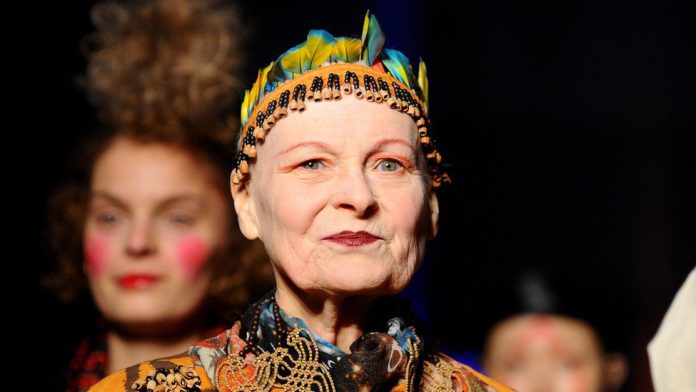Vivienne Westwood (nee Swire) was born on 8 April 1941 in Tintwistle, Cheshire, to Gordon Swire and Dora Swire. Her parents were married a few weeks before the outbreak of the Second World War. She was born into a working-class family, given that at the time of her birth, Westwood’s father worked as a shopfloor hand in an aircraft factory.
When Westwood was seventeen, her family moved to London, where she enrolled in a jewellery design course at the University of Westminster. Incidentally, she quit the course just after one term as she felt that making a mark in the fashion world given a humble background might be an irrational endeavour.
Having temporarily put aside her dreams of being a jewellery designer, Westwood went on to enrol in a teaching training course, eventually becoming a primary school teacher. During this period, Westwood tried her hand at part-time jewellery designing, selling her pieces at a stall on Portobello Road. It was sometime around this time that she met her husband Derek Westwood, whom she wed in 1962. Their son, Benjamin, was born in 1963.
WESTWOOD’S BREAKTHROUGH YEARS
Westwood’s marriage to Derek slowly began to crumble after she began an affair with fellow fashion designer Malcolm McLaren. After the end of her first marriage, Westwood and McLaren moved into Thurleigh Court in Balham, where the couple’s son Joseph Corré was born in 1967. Westwood continued to work as a primary school teacher until 1971, while simultaneously beginning to collaborate with McLaren on designing clothes. During this time, McLaren became the manager of the then-upcoming punk band Sex Pistols, and subsequently, the couple garnered attention as the band wore Westwood’s and McLaren’s designs.
In the first half of the 1970s, punk culture slowly began to seep into mainstream fashion design. Westwood’s and McLaren’s strong advocacy for the nascent movement helped to hasten its growth. Given her deep involvement in this area, Westwood was considered a prominent enabler of the punk fashion phenomenon, and was quoted as saying “I was messianic about punk, seeing if one could put a spoke in the system in some way.” The store that she co-managed with McLaren, SEX, was a meeting place for early members of the London punk scene. Westwood also inspired the style of punk icons, such as Viv Albertine, who wrote in her memoir, “Vivienne and Malcolm use clothes to shock, irritate and provoke a reaction but also to inspire change.” Her eccentric, offbeat designs were also a reflection of Westwood’s strong desire to create designs that had characteristics of anti-establishment elements.
McLaren and Westwood’s first fashion collection to be presented to potential international buyers was called Pirate. Post its remarkable success, the couple went on to present many more collections in Paris and London with the thematic titles Savages (shown late 1981), Buffalo/Nostalgia Of Mud (shown spring 1982), Punkature (shown late 1982), Witches (shown early 1983) and Worlds End 1984 (later renamed Hypnos, shown late 1983), among others. Her partnership with McLaren was dissolved, after which Westwood showed one more collection under the Worlds End label: Clint Eastwood (late 1984–early 1985).
She dubbed the period 1981–85 “New Romantic” and 1988–91 as “The Pagan Years” during which “Vivienne’s heroes changed from punks and ragamuffins to Tatler girls wearing clothes that parodied the upper class”.
LATER YEARS
Vivienne Westwood’s stellar work was acknowledged by every segment of society, including the establishment whose values she had opposed through her works. In 1992, she was awarded an OBE by Queen Elizabeth II for her contribution to the fashion world. Again in 2012, Westwood was chosen as one of The New Elizabethans to mark the Diamond Jubilee of Queen Elizabeth II. A panel of seven academics, journalists and historians named Westwood among a group of 60 people in the UK “whose actions during the reign of Elizabeth II have had a significant impact on lives in these islands and given the age its character”.
Throughout her life, Westwood championed several charitable causes, the most prominent being environmental conservation. Westwood eventually became an ambassador for the clean energy crowdfunding platform Trillion Fund. Like most of her contemporaries have always said of her, Westwood throughout her life lived by her values, which made her stand apart both in personal and professional spheres of life.
After her death was announced, tributes for Westwood poured in from around the world. Many who had worked with her took to social media to share their experiences of interacting with her, adding that his magnetic presence would be missed. Former Sex Pistols guitarist Glen Matlock paid tribute to Westwood, stating that it was “a privilege to have rubbed shoulders with her in the mid-’70s at the birth of punk and the waves it created that still resound today for the disaffected.”
At times a controversial yet enigmatic figure, Westwood will still be remembered for her evocative work.




